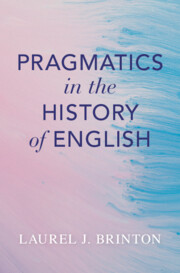Refine search
Actions for selected content:
60 results
6 - Genre, Speech and Writing
-
- Book:
- Historical Sociolinguistics
- Published online:
- 19 December 2025
- Print publication:
- 08 January 2026, pp 111-131
-
- Chapter
- Export citation
Chapter 11 - Ennius’ Saturae and the Registers of Personal Poetry
- from Part III - Personal Ennius
-
-
- Book:
- Ennius Beyond Epic
- Published online:
- 10 December 2025
- Print publication:
- 18 December 2025, pp 241-270
-
- Chapter
- Export citation
6 - Social Aspects of Translating
-
- Book:
- Fundamentals of Translation
- Published online:
- 04 December 2025
- Print publication:
- 11 December 2025, pp 163-198
-
- Chapter
- Export citation
Tonal languages without tone: downstep in Drubea and Numèè (Oceanic, New Caledonia)
-
- Article
-
- You have access
- Open access
- HTML
- Export citation
Register as a source of non-equivalent contracted constructions: going to and gonna in British English
-
- Journal:
- English Language & Linguistics / Volume 29 / Issue 3 / September 2025
- Published online by Cambridge University Press:
- 12 November 2025, pp. 609-630
-
- Article
-
- You have access
- Open access
- HTML
- Export citation
19 - The History of English Registers
- from Part II - Tracking Change in the History of English
-
-
- Book:
- The New Cambridge History of the English Language
- Published online:
- 23 October 2025
- Print publication:
- 23 October 2025, pp 536-571
-
- Chapter
- Export citation
15 - Language Use in Chaucer’s Canterbury Tales
- from Part II - Lighthouse Works and Authors
-
-
- Book:
- The New Cambridge History of the English Language
- Published online:
- 18 October 2025
- Print publication:
- 16 October 2025, pp 371-384
-
- Chapter
- Export citation
21 - Medical and Scientific Writing
- from Part III - Genre and Medium in the Record
-
-
- Book:
- The New Cambridge History of the English Language
- Published online:
- 18 October 2025
- Print publication:
- 16 October 2025, pp 506-533
-
- Chapter
- Export citation
19 - The Language of Religious Texts
- from Part III - Genre and Medium in the Record
-
-
- Book:
- The New Cambridge History of the English Language
- Published online:
- 18 October 2025
- Print publication:
- 16 October 2025, pp 459-481
-
- Chapter
- Export citation
18 - History Writing
- from Part III - Genre and Medium in the Record
-
-
- Book:
- The New Cambridge History of the English Language
- Published online:
- 18 October 2025
- Print publication:
- 16 October 2025, pp 433-458
-
- Chapter
- Export citation
Going forward as an adverb
-
- Journal:
- English Language & Linguistics / Volume 29 / Issue 2 / June 2025
- Published online by Cambridge University Press:
- 24 June 2025, pp. 336-361
-
- Article
-
- You have access
- Open access
- HTML
- Export citation
Chapter 9 - Fidelity of Concepts and Register
-
- Book:
- Translating Virgil
- Published online:
- 15 May 2025
- Print publication:
- 05 June 2025, pp 673-768
-
- Chapter
- Export citation
Chapter 7 - The semantic evolution of Type II-CPs
-
- Book:
- Composite Predicates in English
- Published online:
- 09 May 2025
- Print publication:
- 15 May 2025, pp 125-157
-
- Chapter
- Export citation
7 - Influencing People Around the Globe
- from II - Persuasion and (New) Contexts of Use
-
-
- Book:
- Manipulation, Influence and Deception
- Published online:
- 10 June 2025
- Print publication:
- 24 April 2025, pp 135-154
-
- Chapter
- Export citation
Voicing or register in Jarai dialects? Implications for the reconstruction of Proto-Chamic and for registrogenesis
-
- Journal:
- Journal of the International Phonetic Association / Volume 54 / Issue 2 / August 2024
- Published online by Cambridge University Press:
- 16 May 2024, pp. 635-676
-
- Article
-
- You have access
- Open access
- HTML
- Export citation
Suicides in degenerative neurocognitive disorders and traumatic brain injuries
- Part of
-
- Journal:
- European Psychiatry / Volume 67 / Issue 1 / 2024
- Published online by Cambridge University Press:
- 17 January 2024, e10
-
- Article
-
- You have access
- Open access
- HTML
- Export citation
8 - Discourse: Register, Genre, and Style
-
- Book:
- Pragmatics in the History of English
- Published online:
- 28 September 2023
- Print publication:
- 12 October 2023, pp 185-214
-
- Chapter
- Export citation

Pragmatics in the History of English
-
- Published online:
- 28 September 2023
- Print publication:
- 12 October 2023
Chapter 9 - Indirect Questions in ‘Early Latin’
- from Part II - Drama
-
-
- Book:
- Early Latin
- Published online:
- 27 July 2023
- Print publication:
- 17 August 2023, pp 157-205
-
- Chapter
- Export citation
Chapter 7 - Support Verb Constructions in Plautus and Terence
- from Part II - Drama
-
-
- Book:
- Early Latin
- Published online:
- 27 July 2023
- Print publication:
- 17 August 2023, pp 118-137
-
- Chapter
- Export citation
